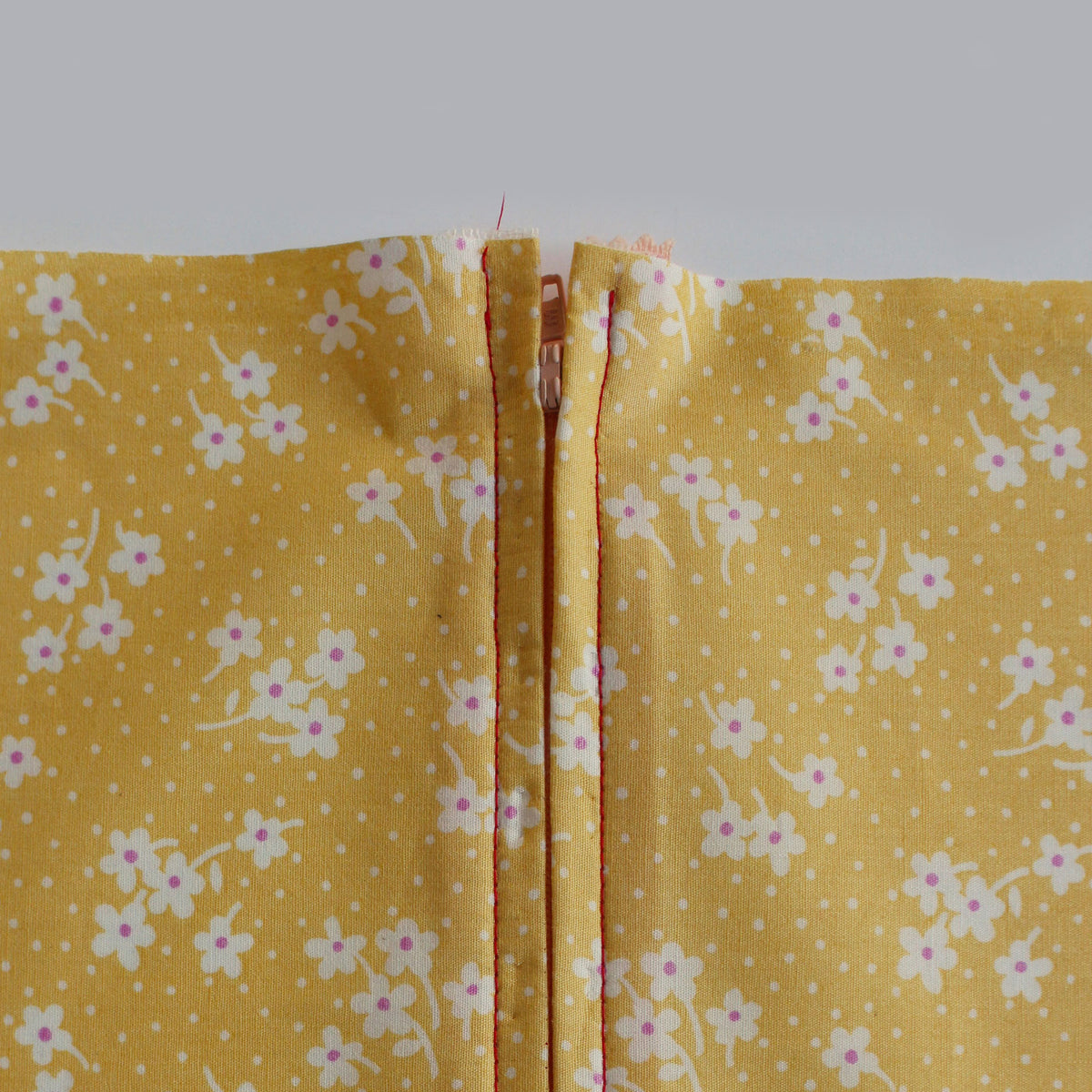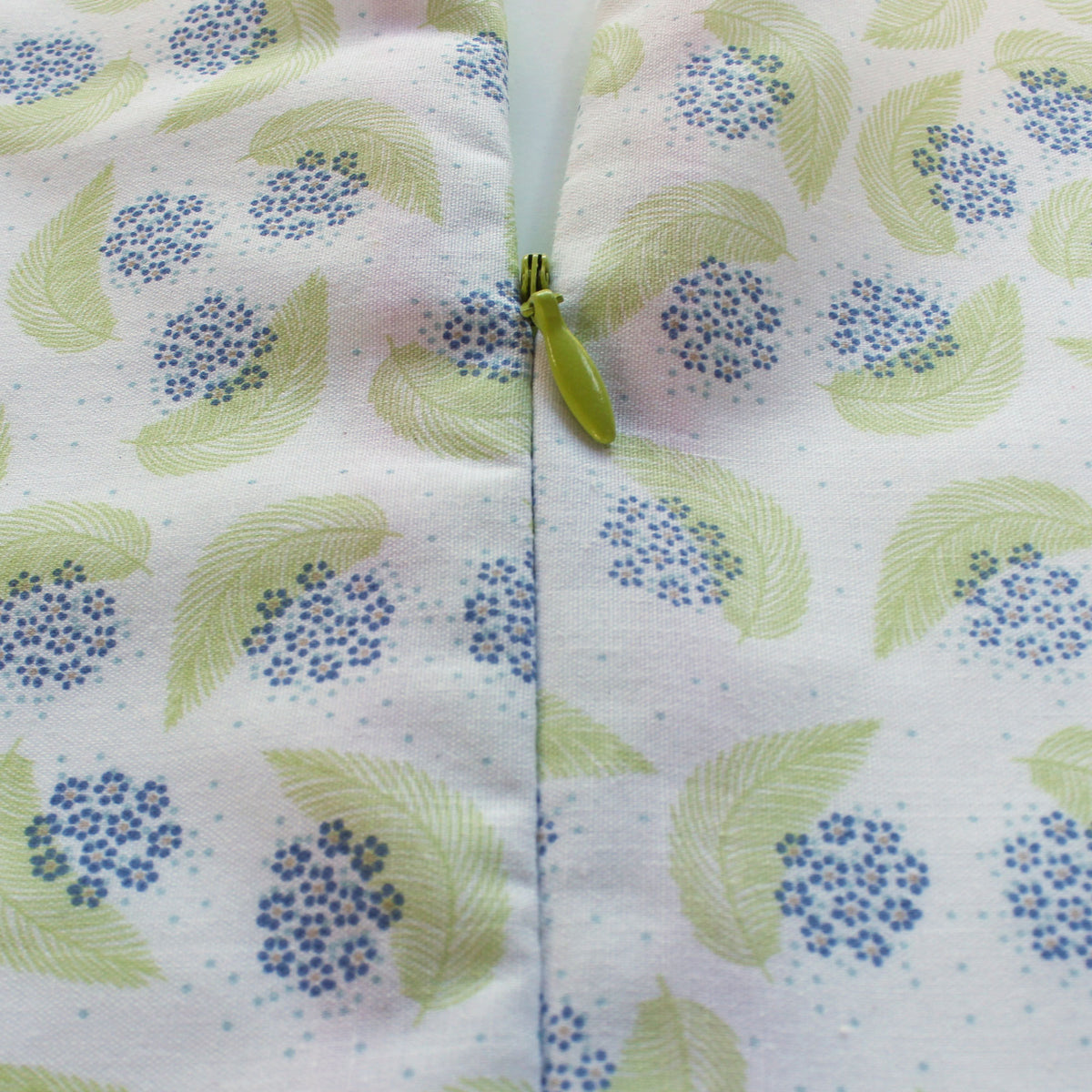Shirring the Sofia Bodice

In the last sew-along tutorial for the Sofia sewalong, we prepared for cutting out the project. If you're just joining in now, make sure to check back to that post.
n this post, we'll sew the bodice shirring for Sofia. We'll discuss how to set up the machine for sewing with elastic thread, how to test and troubleshoot if you run into issues with shirring, and finally, we'll go through each step of shirring the bodice or top.
If this is your first time shirring, I recommend watching this tutorial video I've created. It shows you everything you'll need to know in sewing this technique.
Here are the topics covered in this post:
- How to thread your machine:
- Testing your shirring/troubleshooting
- Sewing the Sofia bodice
Threading the Machine:
The upper portion of the machine is threaded as usual. The bobbin is where we need to change things up, as it is wound by hand with elastic thread. Using the machine’s winding mechanism would create too much tension, affecting the shirring result.
When winding, you want to have some slack. Don’t pull too tightly as you don’t want to engage the stretch in the thread. Give a slight tension as you wind, enough, so the thread isn’t falling off the bobbin.

You’ll need several bobbins of elastic for this project, so I’d suggest that winding a few bobbins before you start will make your workflow more efficient.

Place the bobbin into the case as thread it as you do with regular thread. Once it's in the case, pull on the thread and take note of the tension. It should not be too loose or too tight as you draw the elastic thread from the case. If you encounter either of these issues, you'll need to adjust the bobbin tension.
To adjust bobbin tension for a machine with a removable bobbin case, there is a screw on the outside of the bobbin case that controls the bobbin thread tension.
To adjust bobbin tension for a machine with a drop-in bobbin case, you will be able to change the bobbin tension, but you will need to look into the model of your machine to learn how to access this screw to adjust your bobbin tension.
Here is a video that may be helpful to get you started.
Locate the small screw on the outside of the bobbin case. If the thread is very loose as you pull it from the case, turn the screw to the right with a ¼ turn. If the thread is very tight as you draw it from the case, turn the screw to the left with a ¼ circle rotation.

It's important to know that the screw post is very short, so when adjusting tension, turn it in small rotations. Work on a tabletop surface so that if the screw falls out, you can easily find it.
Don't forget to return the screw to its original position after sewing the shirring; otherwise, this adjusted tension will affect your regular sewing tension.
Machine Settings:
Stitch Length:
Use a straight stitch setting with a stitch length set between 3.5 - 4 mm. The longer the stitch length, the more fabric is taken up per stitch. The stitch length should be tested and adjusted if necessary.
Upper Thread Tension:
Your upper thread tension can be adjusted to achieve more or less stretch. Start with a middle tension of 4. Increase the tension to create more gathers/stretch, or decrease the tension to reduce the amount gathers/stretch.
The elastic thread should lay flat on the backside of the fabric, and the upper thread should hold it securely in place.
Here is a diagram of how your upper thread and bobbin should look from a side view. It's quite different from tension with regular thread. Since the elastic is thick, it cannot pull through the weave of the fabric; that would make it visible on the right side, which isn't a good look.

This image shows shirring from the elastic side. This is correct shirring tension. You can see that the elastic lays flat.

This image shows incorrect tension, although the elastic lays flat, the upper thread is loose and the shirring will not hold in place.

Testing:
Before you begin shirring, I highly recommend practicing on scrap fabric and testing your shirring to make sure you're getting enough stretch. I aim for about 50% stretch, which means that if you shirr a piece of fabric that is 10", it should stretch to about 5", give or take.


Troubleshooting Solutions:
If you seeing enough stretch, or if there is too much stretch, here is a short checklist of solutions that you can try:
- Increase your stitch length will increase the stretch (take up more fabric /stitch).
- Decrease your stitch length will increase the stretch (take up less fabric /stitch).
- Check that the bobbin is would properly.
- Tight bobbin tension will result in more stretch. If you want to reduce stretch, reduce tension (turn bobbin case screw to the left).
- Tight bobbin tension will result in more stretch. If you want to reduce stretch, reduce tension (turn bobbin case screw to the left).
- Higher upper thread tension will increase stretch.
- Lower upper thread tension will relax stretch.
Once you have everything set up correctly, it's time to Get started on shirring the bodice.
Preparing the Bodice for Shirring:
- Finish the upper edge of the Bodice (A) with a serge or zig-zag stitch.
- Turn the upper edge towards the wrong side by 11/4" (3.2 cm). Press the folded edge and pin in place.



Prepare the Crop & Peplum Top Hem
Before sewing the shirring, we'll prepare the hem for the top versions. The hem will be sewn in a later step, but pressing the hem at this point in the project is much easier since the fabric is flat.
- Pre-press the hem edge of the crop and peplum top pieces to prepare for hemming in a later step. Turn the hem towards the wrong side by 3/8" (1 cm) and press. Turn the edge in again by 3/8" (1 cm) and press again.


Shirring Guidelines
Now, it's time to start shirring. One crutial feature with shirring is that the rows are evenly spaced as you sew. The spacing between each row of shirring will be 1/2" (1.3 cm). To achieve even spacing, you can either use a pressure foot that allows for this spacing - the edge of the foot should be 1/2" (1.3) from the center of the foot), or you can create guidelines on the fabric.
If you do not have a pressure foot with this spacing, here's a tutorial that will show you a quick DIY hack for changing your regular foot into a 1/2" guide foot. This is what I'll be using in this tutorial.

If you prefer to mark your fabric with a ruler and chalk, let me show you how to do it.
First, lay the bodice piece right side up and align the hem/waistline edge to the edge of the table; this will help keep the grainline straight.

Begin by marking along the upper edge of the bodice with a ruler and chalk. The first line will be 1/2" (1.3 cm) away from the folded edge.

- Continue to draw lines along the bodice, spacing them 1/2" (1.5 cm) apart.
-
Crop Top: The last shirring line should be approximately 1 3/4"
(4.5 cm) away from the hem edge. -
Peplum: The last shirring line should be approximately 7" (18 cm) away from the hem edge.
-
Dress: The last shirring line should be 1/2" (1.3 cm) away from the waistline edge.

Shirring:
-
Make sure to bring the elastic thread up, and bring both threads underneath the foot.

We'll start by sewing the first two rows of shirring along the upper edge of the bodice. We'll use the backstitch method for these stitches, which simply means that a strong backstitch will be sewn at the beginning and end of the stitch.
It is important to note that we want to secure the upper edge of the bodice in place with these two stitches. These stitches will form a casing for a strip of elastic that will be added later in the project. Let's get started.

Being sewing with the bodice right side up. The fist shirring stitch will be sewn 1/2" (1.3 cm) away from the bodice's folded upper edge. Begin and end the stitch with a backstitch.


- The second line of stitching will be sewn 1/2" (1.3 cm) from the first row. You can now use the guide on your foot to align with the first line of stitching. If you are using a chalk guideline, carefully follow the lines as you sew.

- It is essential to stretch out the fabric in the area that you are sewing so that the fabric lays flat; this prevents puckers from forming along the stitch line.

- Once the stitches are sewn, you will have hemmed the upper edge of the bodice and created a channel for the elastic, which we will insert later in another post.

- Now we will begin sewing along the side edges of the bodice. The remaining stitches will be sewn using the continuous shirring method. This means that all rows of stitching will be sewn in one stitch.
- Note: If you run out of bobbin thread as you are sewn, reload it and begin sewing a few stitches overtop the end of the previous stitch. Sew a small backstitch and continue shirring.
- The first stitch will begin 3/8" (1 cm) down from the curved underarm edge.

- At this point, we are sewing alongside a curved edge. If using the guide foot, align the second shirring line to the 1/2" line on your machines guide plate, until you can align your guide foot with the stitch.

- Stretch the fabric out as you sew and be careful to sew in straight lines.

- Once you reach the other side of the bodice, aim to sew 3/8" (1 cm) down from the curved edge.

- Stop the stitch 1/4" (6mm) away from the side edge. Lift the pressure foot.

- Pivot the foot in the direction of the side edge.

- Adjust the stitch length to 2.5". This reduced stitch length will reduce the amount of shirring stretch, and allow you to "skip" to the next row of shirring without shirring the side seam edge.

- Sew 6-7 stitches along the side edge, so that you will now be 1/2" (1.3 cm) away from the previous shirring stitch.

- Increase your stitch length back to your previous shirring setting.

- Continue sewing the next line of shirring.

- Sew the whole bodice using this method.
- Remember that for the dress, the final stitch line is 1/2"(1.3 cm) away from the waistline edge. The last shirring line for the crop top should be approximately 1 3/4", and for the peplum, the last shirring line should be about 7" (18 cm) away from the hem edge.

- For the dress bodice, as you sew the last line, keep in mind that it is more important to have this final stitch line be spaced 1/2" (1.3 cm) from the waistline edge, than it is to have it evenly spaced 1/2" (1.3 cm) from the previous stitch line.
You'll notice here on my project that the mark on the left side of my guide foot does not align with the previous shirring stitch, but the mark on the right side aligns to the waist edge. It's almost impossible to be totally perfect in the stitch spacing, so when we get to this last stitch, be lenient with yourself :) Having the last stitch spaced 1/2" from the edge will help up later when we attach the skirt.

Congratulations! You've finished shirring the bodice! Stay tuned for the next post in this sewalong series as we move onto the sleeves. If you're making the bishop, cap or elbow sleeve, we're not be done with shirring just yet.You can jump pver to this post to sew shirring on the Sleeve.
If you're making the Bell sleeve, you'll want to first complete the bodice by following this post, and then move onto completing the Bell sleeve.
If you enjoyed this tutorial and want to keep it close at hand, you can save this pin to your Pinterest sewing tutorial board...

YOU MAY ALSO LIKE:
Leave a comment
Comments will be approved before showing up.
Also in The Victory Patterns Blog

Pair the Sofia Bell Sleeve Strap with any sleeve option

How to sew a centered zipper
A centered zipper is one of the most usefull zippers to be able to sew. They are commonly used in skirts, dresses, and pants, as well as cushion covers and handbags. In this tutorial, we'll show you how to sew a centered zipper using directional sewing, which avoids the fabric from shifting in different directions once the zipper is sewn in.



